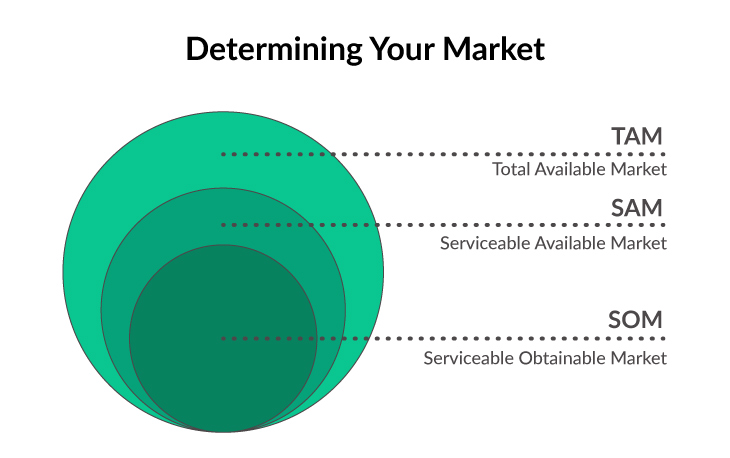What Is Product-Market Fit?

Last Updated: By TRUiC Team
According to prolific entrepreneur Marc Andreessen, “The only thing that matters is getting to product-market fit.”
Product-market fit may be one of the most important yet vastly misunderstood concepts in the startup world. Yet many startups miss the mark. A lack of strong market demand for a product is one of the top reasons startups fail.
This guide defines product-market fit, why it is important for startups to understand, and how to find it for your startup.
Skip Ahead:
What Is Product-Market Fit?
Product-market fit refers to the fit between a product, its desire by the market, and its ability to satisfy customers’ needs. It occurs when a startup or development team focuses on a problem or need in the market and builds a product or service that customers want.
Legendary Silicon Valley entrepreneur Marc Andreessen is credited with popularizing this idea. In his blog, “The Only Thing That Matters,” Andreessen describes product-market fit as “being in a good market with a product that can satisfy that market.” It begins when a startup finds a set of customers or users to serve with their product or service, and grows as a startup iterates toward the market's wants and needs.
We can break product-market fit down into two parts.
- The desirability of the product by the market. What this means is that there is actually a problem worth solving in the first place. You need to solve a real problem that someone is willing to pay for. A solution that isn’t solving a real problem isn’t usually desirable in the market.
- The feasibility of the product to satisfy the customers’ needs. The product or service needs to uniquely satisfy a need. First, it needs to actually satisfy a need. And second, it should be a solution that solves a problem in a way that stands out.
This idea is also articulated well in Dan Olsen’s Product-Market Fit Pyramid. Product-market fit is the tie between the market and the product. It connects the target customer and the market’s underserved needs with your value proposition, features, and user experience.
Why Is Product-Market Fit Important?
Until you determine you have product-market fit, you don’t know whether your solution is actually solving a real problem and you have a market big enough to sustain it. Prior to achieving product-market fit, you are really just hypothesizing and experimenting.
One of the biggest problems startups face is not finding a market for their product or service. Often entrepreneurs believe they will find a market for their product or service but never actually achieve product-market fit.
Once you attain product-market fit, the benefits don’t stop at just finding a market that wants your product or service. When you achieve product-market fit, more often than not, your customers will sell for you. Think about all of the instances where consumers are buying, using, and promoting products through ratings and reviews, “word of mouth” advertising, and referrals.
Product-Market Fit for Startups
Product-market fit is especially important for startups. Finding and reaching a market is one of the most difficult tasks in developing a new product or service and one of the top reasons for startup failure.
No one wants to waste precious time and resources developing and building products that no one wants. By taking the time to find and work toward product-market fit, startups can reduce costs, reduce risks, and increase their chances of success.
“Why do so many founders build things no one wants? Because they begin by trying to think of startup ideas. That m.o. is doubly dangerous: it doesn’t merely yield few good ideas; it yields bad ideas that sound plausible enough to fool you into working on them.” -Paul Graham, Co-founder and Partner, Y Combinator
How to Find Product-Market Fit
In order for someone to want your product or service it:
- Needs to solve a real problem and
- Satisfy the needs of a specific market.
Although there are many different ways to approach solving product-market fit, it is best to start finding the problem you are solving, your likely audience, and then listening to what your audience wants and needs.
Find a Problem
The first step is figuring out what problem your product or service idea is solving. In order to create a successful product, your idea needs to meet the needs of the market. It needs to solve an actual problem that your target audience has, satisfy the customer’s needs, and your target market needs to be willing to pay for it.
Ideally, you will identify a real problem that no other product or service efficiently solves. Start by asking, “who will benefit from my product or service and why?” Both of these aspects are important. The “who” will clue you in on your audience, and the “why” will provide some insights into the underlying problems that your product or service is solving.
You will want to focus your product or service solution on the areas that provide the biggest pain points. These are the things that are most important to your users and customers and the ones that they are desperate to find a solution to.
You might consider studying research that already exists such as government data, industry reports, and trade publications or it may involve conducting your own market research like surveys and customer interviews with those who you believe might be your most likely potential customers.
You should also spend some time researching your competitors. Although you may believe your product or service is unique, chances are your target audience is solving the problem that your solution intends to solve in some way or another.
Do you see any of the same complaints over and over? What problems or needs are your potential customers looking for solutions for? How can you solve those problems with your product or service idea?
Find Your Target Audience
Who will benefit most from your product? Is there one particular group of users or customers that might be early adopters or your most likely customers?
This is an important step because once you know the answer to these questions, you can then start to brainstorm what your customer base looks like.
Next, you will want to carry out some additional research on your target audience. Use resources like Facebook groups, forums, blogs, and other social feeds to see what people are talking about, complaining about, and sharing. Take notes of who these people are and what their daily lives might look like: What do they follow and read? How do they spend their time? Where can you find them online? With these things in mind, you can begin catering your messaging directly to them.
Find Your Unique Value
The next step is defining your product and value proposition. What makes your product or service different and stand out from the rest?
While finding your unique value proposition, or your unique selling proposition, can be difficult, there are a number of things you can do to help.
Start by asking your audience what they struggle most with when looking for a solution to this problem. What alternatives have they tried? Why didn’t the alternatives satisfy their need? What problems still persist? This will give you a pretty good idea of what your customers are looking for in a solution. Plus, it will allow you to develop your product or service and craft your messaging and unique selling proposition to meet your market’s needs.
You can also search online reviews for similar products, your competitors, and other alternatives. Pay attention to what people complain about over and over. What needs are not being met? How can you meet them?
Build an MVP
The next step in finding product-market fit is to develop a minimum viable product ( MVP). An MVP is a product or service that has just enough features to attract some early-adopter users or customers for the purpose of validating a product idea as quickly and easily as possible.
With an MVP, not only can you validate that customers will actually use or purchase your product or service, but it also gives you the opportunity to collect invaluable feedback during the development process.
Your minimum viable product should be just that, minimum. This idea is to focus on the core features that solve your users’ or customers’ problems and then learn from the feedback you receive about what features to develop next.
Test With Real Users, Learn, and Iterate
Next, launch your MVP, test it with real users, measure outcomes, learn, and iterate. This is how you get the feedback to develop a product that solves a real problem and satisfies customers’ needs.
An MVP gives you the opportunity to observe and test how customers or users interact with your product or service.
Depending on the type of MVP you build, you can test your messaging, pricing, desired features, and even the technological parts of your product or service. In application and software development, this is especially important, as a prototype may show how things should work. Only through quality control and testing with actual users will you find out if and how things actually work.
Testing your product can determine whether there is room for improvement or if your product just isn’t making the cut. If your product isn’t cutting it, you may need to pivot. You may need to try a different messaging, a different audience, or even create an entirely different product altogether.
In many cases, such as software development, this process will continue through the lifecycle of your product or service. Through proof of concepts, prototypes, alpha releases, beta releases, and versions 1.0 to 99.9 will all require you to build, measure, learn, and iterate.
How to Measure Product-Market Fit
Measuring product-market fit highly depends on the type of product or service and where you are in the product life cycle. However, there are three basic steps to understand whether you have achieved product-market fit.
Step 1: Research the Market
Articles, industry publications, government data, competitor websites, and social media are all great ways to research your industry and market.
- What does the future of the market look like?
- What are your competitors doing?
- What are your target customers saying?
- [How] Does your product meet the needs of the market?
You should also be gathering customer feedback directly. You can use surveys, focus groups, one-on-one interviews, or a number of other methods, but the important thing is to ask.
Step 2: Determine the Size of Your Market
Next, you will need to determine whether you have found a market large enough to support your startup. To do this, you will need to understand the size of the market.
- How large is your market, and what is the revenue potential?
- Is there a large enough market to make your product/startup viable?
In order to determine the size of your market, there are three things that you need to determine, the total addressable market, the serviceable addressable market, and the serviceable obtainable market.
- Total Addressable Market (TAM): The TAM is the entire size of the market for your product or service. This includes all of the people or businesses that have the problem to which your solution solves.
- Serviceable Addressable Market (SAM): The SAM is a subset of the total market that you can actually reach. Your SAM may be influenced by many factors, including the cost and the geography you serve.
- Serviceable Obtainable Market (SOM): The SOM is a subset of your reachable market that you might be able to acquire realistically. Of course, determining your SOM will depend on your industry and is highly subjective. However, this will give you a good idea of your revenue potential.

To determine the total potential revenue, apply your expected average revenue per user (ARPU) to the number of users in your SOM. This can be expressed with the following equation:
Total Potential Revenue = ARPU x SOM
Step 3: Measure
Finally, there are a number of key performance indicators (KPIs) that you can use to measure product-market fit depending on the type of product or service. Startups on their way to achieving successful product-market fit should see significant improvement in many of their KPIs.
Here are some useful KPIs and metrics:
Net Promoter Score
A Net Promoter Score (NPS) survey is one popular way of measuring product-market fit. Your NPS measures your customers’ willingness to recommend your product to people they know. The NPS simply asks customers or users: “How likely are you to recommend [product X] to a friend or colleague?”
Users are asked to rate how likely they are to refer your product to others on a scale of 0 to 10 where 0 is “not at all likely” and 10 is “highly likely.”
Users are then categorized on how likely they are to promote your product. Users who rated their likelihood a 9 or 10 are Promoters. Users rated their likelihood 7 or 8 are Neutral. Users who rated their likelihood as 0-6 are Detractors.
The NPS is then calculated by subtracting the percentage of detractors from the percentage of promoters.
Since your NPS can range from -100 (everyone is a detractor) to +100 (everyone is a promoter), you should aim to achieve at least a positive score. This means you are at least beginning to determine product-market fit.
Product-Market Fit Test
One way to directly measure your product-market fit is with a PMF survey. A PMF survey, also known as a “Sean Ellis test,” simply asks users:
“How would you feel if you could no longer use [product X]?”
- Not Disappointed
- Somewhat Disappointed
- Very Disappointed
- N/A No Longer Use
Of course, you would hope your customers or users would be very disappointed if they could no longer use your product or service. According to Sean Ellis, the magic number you want to see to know that you have achieved product-market fit is 40% of customers being very disappointed if they could no longer use your product.
Customer Satisfaction
The customer satisfaction score (CSAT) can be assessed by asking users a simple question like:
“How satisfied were you with your experience today?”
- Very Satisfied
- Somewhat Satisfied
- Neither Satisfied nor Dissatisfied
- Somewhat Dissatisfied
- Very Dissatisfied
You can ask users to rate you on a 3, 5, 7, or even a 10-point scale.
Churn
Churn is when a customer stops using/purchasing your product or service, and the churn rate is typically described as a percentage of customers that stopped doing business with you within a specific period.
A low churn rate means that you have a higher product-market fit. If your churn rate is high, you have a lower product-market fit. If you have a high churn rate, try to survey or interview your customers who are leaving to understand why and what you can do to better satisfy your customers’ needs.
Customer Retention
Retention is the opposite of churn. Where churn measures the loss of a customer, retention measures how many existing users you retained. The customer retention rate is typically described as a percentage of customers that you retained within a specific period.
A high (or growing) retention rate means that you are on your way to achieving product-market fit. If your retention rate is low, survey or interview the customers that you are not retaining and try to figure out why and what you can do to increase your customer retention.
Customer Lifetime Value
Yet another way to gain insights on your product-market fit is to examine your Customer Lifetime Value (CLV). This is the average value you expect over a customer's lifetime.
A high (or growing) CLV indicates that customers are staying with your brand longer and spending more. How long and how much a customer spends is closely related to the value that they receive from you.
Other KPIs and Metrics
There are a number of other KPIs and metrics that can help you assess product-market fit.
Useful KPIs and metrics might include: growth rate, conversion rate, customer acquisition costs, customer engagement, retention curves, average revenue per account, word of mouth and organic growth, and product usage intervals.
Frequently Asked Questions
How can you test product-market fit?
You can test and measure product-market fit using a number of KPIs and metrics. Some of the most popular measures of product-market fit include the net promoter Score (NPS), Churn, Customer Retention, and so forth.
Other measures include growth rate, market share, conversion rate, customer acquisition costs, customer engagement, retention curves, average revenue per account, word of mouth and organic growth, and product usage intervals.
How do you maintain product-market fit?
Maintaining product-market fit can be just as tricky as finding it. To maintain it, you need to stay responsive to your customers and the market and continue delivering them a product that solves a problem and satisfies their needs. Maintaining product-market fit requires a customer-focused approach to development and a commitment to building, measuring, and learning.
What is the difference between product-market fit vs. traction?
Traction refers to a period of growth leading from one phase of product or service adoption to another. Gaining traction and achieving product-market fit go hand-in-hand, although there is some debate whether traction occurs leading up to finding product-market fit or once you achieve it.


